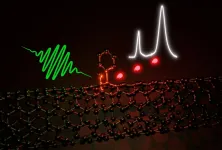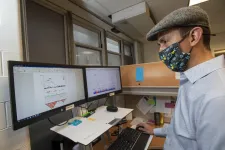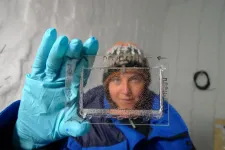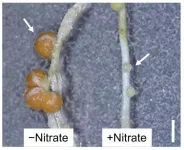Optically active defects improve carbon nanotubes
Heidelberg scientists achieve defect control with a new reaction pathway
2021-04-09
(Press-News.org) The properties of carbon-based nanomaterials can be altered and engineered through the deliberate introduction of certain structural "imperfections" or defects. The challenge, however, is to control the number and type of these defects. In the case of carbon nanotubes - microscopically small tubular compounds that emit light in the near-infrared - chemists and materials scientists at Heidelberg University led by Prof. Dr Jana Zaumseil have now demonstrated a new reaction pathway to enable such defect control. It results in specific optically active defects - so-called sp3 defects - which are more luminescent and can emit single photons, that is, particles of light. The efficient emission of near-infrared light is important for applications in telecommunication and biological imaging.
Usually defects are considered something "bad" that negatively affects the properties of a material, making it less perfect. However, in certain nanomaterials such as carbon nanotubes these "imperfections" can result in something "good" and enable new functionalities. Here, the precise type of defects is crucial. Carbon nanotubes consist of rolled-up sheets of a hexagonal lattice of sp2 carbon atoms, as they also occur in benzene. These hollow tubes are about one nanometer in diameter and up to several micrometers long.
Through certain chemical reactions, a few sp2 carbon atoms of the lattice can be turned into sp3 carbon, which is also found in methane or diamond. This changes the local electronic structure of the carbon nanotube and results in an optically active defect. These sp3 defects emit light even further in the near-infrared and are overall more luminescent than nanotubes that have not been functionalised. Due to the geometry of carbon nanotubes, the precise position of the introduced sp3 carbon atoms determines the optical properties of the defects. "Unfortunately, so far there has been very little control over what defects are formed," says Jana Zaumseil, who is a professor at the Institute for Physical Chemistry and a member of the Centre for Advanced Materials at Heidelberg University.
The Heidelberg scientist and her team recently demonstrated a new chemical reaction pathway that enables defect control and the selective creation of only one specific type of sp3 defect. These optically active defects are "better" than any of the previously introduced "imperfections". Not only are they more luminescent, they also show single-photon emission at room temperature, Prof. Zaumseil explains. In this process, only one photon is emitted at a time, which is a prerequisite for quantum cryptography and highly secure telecommunication.
According to Simon Settele, a doctoral student in Prof. Zaumseil's research group and the first author on the paper reporting these results, this new functionalisation method - a nucleophilic addition - is very simple and does not require any special equipment. "We are only just starting to explore the potential applications. Many chemical and photophysical aspects are still unknown. However, the goal is to create even better defects."
This research is part of the project "Trions and sp3-Defects in Single-walled Carbon Nanotubes for Optoelectronics" (TRIFECTs), led by Prof. Zaumseil and funded by an ERC Consolidator Grant of the European Research Council (ERC). Its goal is to understand and engineer the electronic and optical properties of defects in carbon nanotubes.
"The chemical differences between these defects are subtle and the desired binding configuration is usually only formed in a minority of nanotubes. Being able to produce large numbers of nanotubes with a specific defect and with controlled defect densities paves the way for optoelectronic devices as well as electrically pumped single-photon sources, which are needed for future applications in quantum cryptography," Prof. Zaumseil says.
INFORMATION:
Also involved in this research were scientists from Ludwig Maximilian University of Munich and the Munich Center for Quantum Science and Technology. The results were published in the journal "Nature Communications".
[Attachments] See images for this press release:

ELSE PRESS RELEASES FROM THIS DATE:
2021-04-09
A new study using human genetics suggests researchers should prioritize clinical trials of drugs that target two proteins to manage COVID-19 in its early stages.
The findings appeared online in the journal Nature Medicine in March 2021.
Based on their analyses, the researchers are calling for prioritizing clinical trials of drugs targeting the proteins IFNAR2 and ACE2. The goal is to identify existing drugs, either FDA-approved or in clinical development for other conditions, that can be repurposed for the early management of COVID-19. Doing so, they say, will help keep people with the virus from being hospitalized.
IFNAR2 is the target ...
2021-04-09
PHILADELPHIA - Psychosocial stress - typically resulting from difficulty coping with challenging environments - may work synergistically to put women at significantly higher risk of developing coronary heart disease, according to a study by researchers at Drexel University's Dornsife School of Public Health, recently published in the Journal of the American Heart Association.
The study specifically suggests that the effects of job strain and social strain -- the negative aspect of social relationships -- on women is a powerful one-two punch. Together they are associated with a 21% higher risk of developing coronary heart disease. Job strain ...
2021-04-09
There are millions of people who face the loss of their eyesight from degenerative eye diseases. The genetic disorder retinitis pigmentosa alone affects 1 in 4,000 people worldwide.
Today, there is technology available to offer partial eyesight to people with that syndrome. The Argus II, the world's first retinal prosthesis, reproduces some functions of a part of the eye essential to vision, to allow users to perceive movement and shapes.
While the field of retinal prostheses is still in its infancy, for hundreds of users around the globe, the "bionic eye" enriches the way they interact with the world on a daily basis. For instance, seeing outlines of objects enables them to move around unfamiliar environments with increased safety.
That is ...
2021-04-09
A new biosealant therapy may help to stabilize injuries that cause cartilage to break down, paving the way for a future fix or - even better - begin working right away with new cells to enhance healing, according to a new animal-based study by researchers at the Perelman School of Medicine at the University of Pennsylvania. Their research was published in Advanced Healthcare Materials.
"Our research shows that using our hyaluronic acid hydrogel system at least temporarily stops cartilage degeneration that commonly occurs after injury and causes pain in joints," said the study's senior author, Robert Mauck, PhD, a professor of Orthopaedic Surgery and the director of Penn Medicine's McKay Orthopaedic Research Laboratory. "In addition to pausing cartilage breakdown, we think that applying ...
2021-04-09
Experts have uncovered a new molecular reason why faecal transplants are highly effective in treating infections such as C. difficile (a nasty bacteria that can infect the bowel), which could lead to more targeted treatments for this and other similar diseases.
The study, published today in Gastroenterology, was led by experts from the University of Nottingham and Nottingham Trent University.
Clostridium difficile, also known as C. difficile or C. diff, is a bacterium that can infect the bowel and cause diarrhoea. The infection most commonly affects people who have recently been treated with antibiotics. It can spread easily to others.
A stool transplant - or to give it its full title "a faecal ...
2021-04-09
New York, NY (April 9, 2021) - Sets of genes associated with resistance to immunotherapy in patients with metastatic urothelial cancer of the bladder have been identified and validated by researchers at Mount Sinai. In a study published in Clinical Cancer Research, the team uncovered gene signatures representing adaptive immunity and pro-tumorigenic inflammation that were responsible for sensitivity or resistance to immune checkpoint inhibitors, drugs that help the body's immune system recognize and attack cancerous cells.
"These findings enabled us to identify potential biomarkers in patients who are less likely to respond favorably to immune checkpoint inhibitors, as well as new combination therapeutic approaches that might overcome such resistance ...
2021-04-09
Nine out of ten Danes say that they will accept the COVID-19 vaccine when offered. This is the same level as before the AstraZeneca vaccine was paused.
This is shown by a questionnaire-based survey collected by Søren Dinesen Østergaard and co-authors. He is professor at the Department of Clinical Medicine at Aarhus University and affiliated with the Department of Affective Disorders at Aarhus University Hospital, Psychiatry.
"In February 2021, we asked a sample of Danes whether they were willing to be vaccinated against the coronavirus, and 89 per cent replied that they would. This picture was unchanged when the same people were asked again after the pausing of the AstraZeneca vaccine," says Søren Dinesen Østergaard. ...
2021-04-09
Throughout the last ice age, the climate changed repeatedly and rapidly during so-called Dansgaard-Oeschger events, where Greenland temperatures rose between 5 and 16 degrees Celsius in decades. When certain parts of the climate system changed, other parts of the climate system followed like a series of dominos toppling in succession. This is the conclusion from an analysis of ice-core data by a group of researchers that included postdoc Emilie Capron and associate professor Sune Olander Rasmussen from the Section for the Physics of Ice, Climate and Earth at the Niels Bohr ...
2021-04-09
Tsukuba, Japan - Plants in the bean family (legumes) form nodules on their roots to take up nitrogen. Legumes will stop nodule production when nitrogen is plentiful (Figure 1), but precisely how nitrate presence controls nodule formation in these plants has been a mystery. Now, researchers from Japan have found that interactions between proteins and nitrate can induce and repress genes, controlling nodulation with potential applications in sustainable agriculture.
In a study published in April in The Plant Cell, a research team from the University of Tsukuba has shown that the different DNA-binding properties between proteins that establish nodule development determine if genes involved in symbiosis that govern nodulation turn on or off and that ...
2021-04-09
Two studies led by the Mental Health Unit of the Virgen del Rocio University Hospital and involving researchers from the US conclude that antipsychotic drugs could have a protective effect against SARS-CoV-2. For this reason, patients treated with these drugs have a lower risk of becoming infected or suffer a milder form of the disease if they do become infected.
Thus, a first descriptive epidemiological study of a sample of 698 patients treated with antipsychotics at the Seville hospital revealed that antipsychotic drugs could provide protection against both infection and the tendency to clinical severity of Covid-19 infection. "These are very interesting findings that reflect a clinical reality where we see few patients ...
LAST 30 PRESS RELEASES:
[Press-News.org] Optically active defects improve carbon nanotubes
Heidelberg scientists achieve defect control with a new reaction pathway





